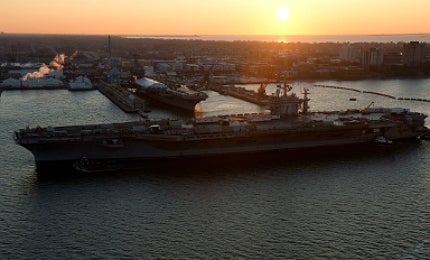

USS Abraham Lincoln to undergo refuelling and complex overhaul

Huntington Ingalls Industries (HII) was awarded a $2.6bn cost-plus-incentive-fee contract by the US Navy to refuel and overhaul the fifth Nimitz-Class nuclear-powered aircraft carrier, USS Abraham Lincoln (CVN 72).
The contract will see HII refuel the ship’s reactors and perform extensive modernisation work on more than 2,300 compartments, 600 tanks and hundreds of systems, while also including upgrades to the vessel’s flight deck, catapults, combat systems and island.
The overhaul will also see the carrier receive Joint Strike Fighter modifications, allowing the aircraft to operate from it when it returns to service in 2017.
The aircraft carrier’s overhaul programme was delayed by six weeks due to defence budget uncertainties and a lag in funding for the work.
Virginia Tech Researchers develop robotic jellyfish for US Navy

Researchers from Virginia Tech College revealed a new autonomous robotic jellyfish prototype, capable of performing underwater surveillance for the US Navy.
The prototype was developed as part of a nationwide, multi-university project, aiming to develop self-powering, autonomous machines that support various missions, including surveillance, oceanographic mapping and monitoring of ocean currents.
Based on the real giant jellyfish Cyanea capillata, the Cyro robotic prototype follows a previous, smaller, hand-sized version of the robot, known as RoboJelly, which is also being constructed by the same research team.
During testing, Cyro demonstrated its ability to swim autonomously and simultaneously collected, stored, analysed and communicated sensory data.
US Navy orders development of high-altitude anti-submarine weapon

The US Navy awarded a firm-fixed price contract to Boeing to develop and deliver high altitude anti-submarine warfare weapon capabilities using smart bomb technology to serve as an anti-submarine weapon.
The company will also design HAAWC air launch accessory (ALA) assets and equipment, in addition to associated engineering services and support.
Boeing will adapt technologies from its Joint Direct Attack Munition and Small Diameter Bomb, to help in the development of the glide weapon to reduce development risks and the cost for the navy.
Designed for internal and external carriage, the SDB system is the next-generation of low-cost and low collateral-damage precision strike weapons.
UK seeks Tomahawk weapon system support from US

The US Defense Security Cooperation Agency notified Congress of a potential foreign military sale of Tomahawk Weapon System support and associated equipment to the UK.
The UK requested support for the weapon system, including missile modifications, maintenance, spare and repair parts, system and test equipment, as well as engineering support.
Enabling lifecycle support, the follow-on support will also help in maintaining the system’s operational effectiveness and safeguard its deployed troops, regional security and interoperability with the US.
Prime contractors of the programme will include Raytheon Missile Systems, Lockheed Martin, Boeing, BAE North America, COMGLOBAL and SAIC.
Italian Navy’s atmospheric diving systems upgraded by OceanWorks

OceanWorks completed a major system upgrade of the Italian Navy’s atmospheric diving system, used to provide improved operational, maintenance and training capabilities.
The latest configuration overhaul includes the installation of Saab Seaeye SM7 thrusters and a completely re-designed electronics, communication and monitoring system, enabling better control and monitoring of system performance by the pilot and supervisor.
The system has been designed to support range of missions for military, including search, salvage, aircraft crash site investigation and recovery, test weapons recovery and submarine emergency ventilation and decompression system (SEVDS) deployment.


.gif)

